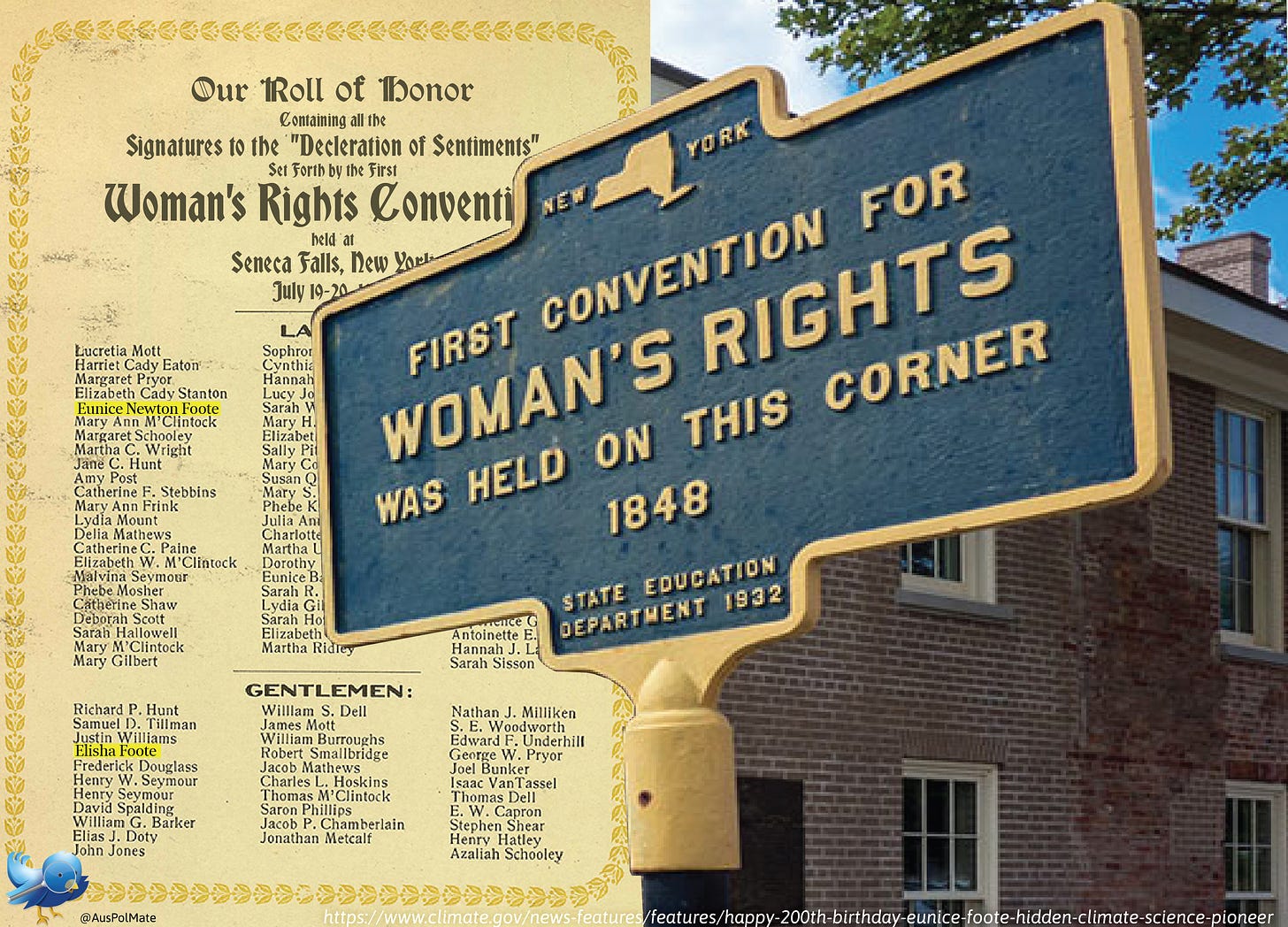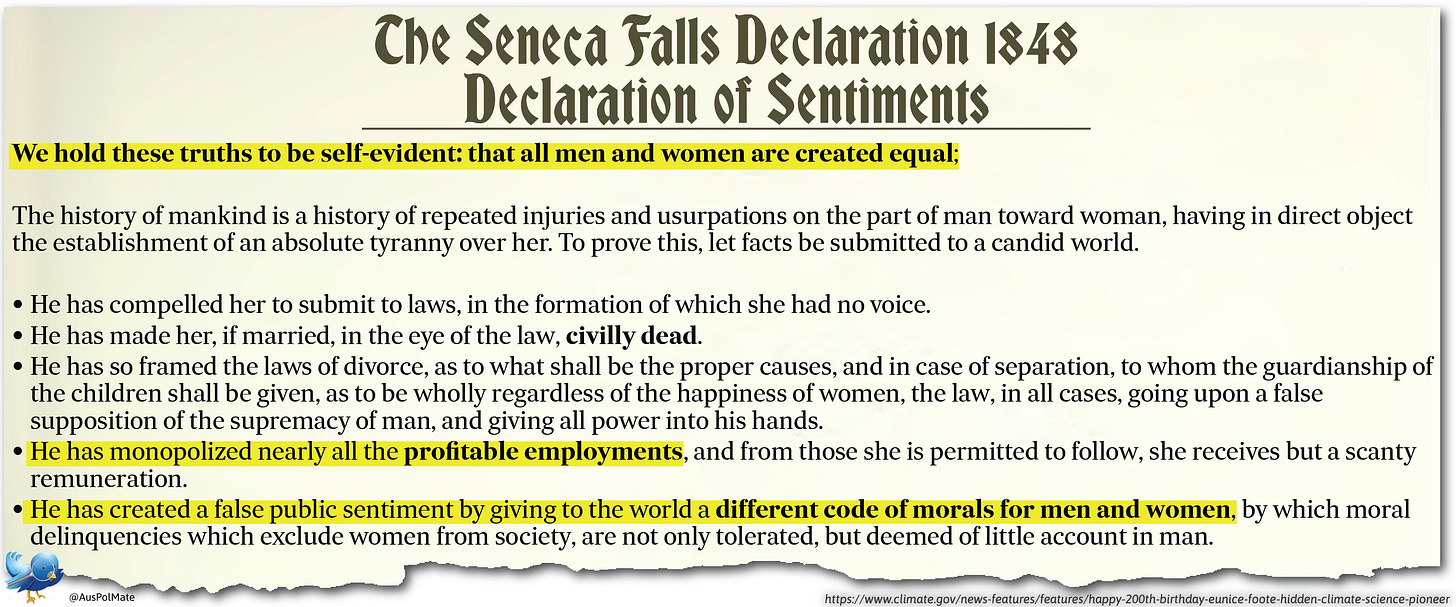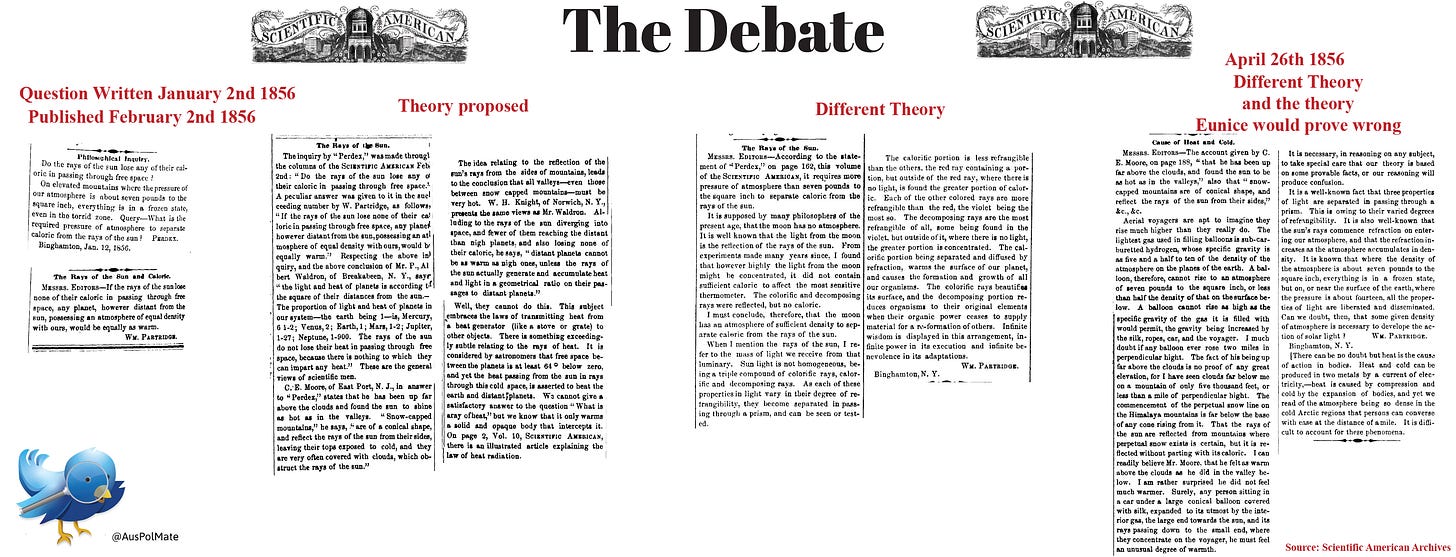The mother of climate change
A look at Eunice Foote and the possible plagiarism of her work by John Tyndall
EUNICE FOOTE - THE PASSIONATE ACTIVIST
In 1856, Eunice Foote was the first scientist to produce experimental evidence that linked carbon dioxide and global warming. Foote’s discovery is made remarkable by her observation that an increase in Carbon Dioxide would result in an increase in atmospheric temperature.
Born as Eunice Newton in 1819, Eunice married Elisha Foote in 1841. Eunice Foote is best described as an intellectual person, a passionate amateur scientist, an inventor, and a women’s rights campaigner.
To fully appreciate Eunice Foote, we need to look beyond her intellect. Eunice was a fierce advocate and campaigner for woman’s rights.
The first convention for women’s rights was held in 1848. Below is a small, unassuming sign that today marks where the convention was held. Alongside the sign are the signatures of convention attendees who endorsed the declaration of self-evident inequalities that existed between men.
Particularly noteworthy was the inclusion of men as signatories to the declaration. Highlighted are the names of both Eunice and her husband Elisha.
The self-evident truths include several truths that still resonate today. A cut-down list of the self-evident truths is shown below. In my opinion, the ongoing sexism that pervades so many religious institutions ensures that the codes of morality for men and women will remain unequal.
EUNICE FOOTE - THE INVENTOR
Eunice may be described or diagnosed as hyperactive these days. Evidence of this is found in the patent archives. Eunice patented multiple inventions. Some people see an opportunity in every problem, and I would ascribe this sentiment to Eunice Foote. These three patents appear to have been born of personal frustration with the products she used, triggering her to design a better version.
Note: searching old patent archives can be a bit hit and miss with digital scanning missing or misspelling some words. Consequently, finding all of Eunice’s patents would consume too much time.
EUNICE FOOTE - THE EXPERIMENT
Eunice’s motivation to undertake the now famous experiment is likely to have emanated from an 1850s equivalent of a Twitter war. A question written on January 2nd 1856, to the Scientific American, resulted in multiple replies & responses. Over the following three months, debate and discussion ensued. No one could prove their view as accurate, as logical arguments could be made for the differing opinions.
I would like to think Eunice read the conjecture and musings of the debate and became bemused as to why someone wouldn’t conduct a simple experiment to settle the argument.
Eunice’s experiment cut through the ‘theoretical’ debate to render the position put forward by Wm, Partridge as wrong. Partridge took the position that atmospheric density, and not the angularity of the sun's rays, was the principal reason why it was warmer in valleys than on the tops of mountains.
The core of Eunice’s experiment was to fill multiple containers with different gases and compare both the rate of temperature change and the temperature reached. The quote “Everything seems obvious in hindsight” applies to Eunice’s work. We must admire Eunice for her ability to generate an obvious solution to resolving a seemingly unresolvable and complex argument.
Eunice’s work was presented by the secretary of the Smithsonian Institute (Joseph Henry) at the American Association for the Advancement conference (AAAS) in August 1856. We do not know why Eunice didn’t present her own work.
It would be tempting to assume this was the result of sexism. particularly as Eunice’s husband, Elisha, presented his own work at the same conference.
While sexism was rampant, a few facts point to a far less controversial explanation.
The AAAS was formed in 1848, and records show that female astronomer Maria Mitchell became a member in 1850.
The effect of two rules in the society’s constitution may also explain why Henry presented Eunice’s work. Rule 11 stated that only committee members could accept a paper, and Rule 19 described how members could submit papers. No provision was made for non-members submitting papers.
Records show Eunice’s husband, Elisha, became a member in August 1856 (10th AAAS Proceedings). Elisha likely submitted Eunice’s paper to the committee. Given Henry’s standing in the scientific community, his choice to present Eunice’s work would’ve added credibility to her work.
AAAS membership entitled the person to receive copies of the Journals and publications. It would be logical for Eunice and Elisha to see no benefit in paying for a second membership when they got no additional value.
If the AAAS committee were sexist, it would be hard to reconcile why Eunice’s work was accepted at all. Logically it would’ve been far easier to reject the paper outright.
Joseph Henry displayed an unequivocal view of women as equals and promoted that view on many occasions, examples include;
"Science was of no country and of no sex. The sphere of woman embraces not only the beautiful and the useful but the true”.
“The columns of the SCIENTIFIC AMERICAN have been often times graced with articles on scientific subjects, by ladies, which would do honor to men of the highest scientific reputation; and the experiments of Mrs Foote afford abundant evidence of the ability of women to investigate any subject with originality and precision.”
Henry’s frustration with sexism in the scientific community can be seen by his used of sarcasm when describing how Eunice’s experiment resolved the argument being conducted in the Scientific American, “this we are happy to say has been done by a lady”—shown in the above extract.
Joseph Henry appears to have provided articles about Eunice’s work to Newspapers. The articles all stated clearly that women were equal to men. Including Eunice’s work in Newspapers further increases the significance of her discovery. Were Joseph sexist, he would’ve been unlikely to put effort into publishing it, let alone including positive statements about women's intellect.
Further reinforcing the significance of Eunice’s work was its inclusion in the “Annual Science Discovery book of the most important discoveries and improvements”. I believe the experiment’s significance was further elevated by having the Secretary of the Smithsonian Institute (Joseph Henry) read the work.
Fun Fact: Victoria (Australia) receives a special mention in this publication. The “Proceedings of the Philosophical Society of Victoria” were sent to the yearbook editor. He wrote about his surprise with the quality of the work coming from Victoria. David wrote, “It is difficult to realize that a scientific and learned society should be in full and vigorous action in a land which so recently was considered a terra incognita.
EUNICE - Today's Controversy
Including Eunice and Elisha’s work in “The American Journal of Science and Arts” is the beginning of a controversy that has captured today’s historians & climate scientists. Eunice’s work was printed immediately following Elisha’s work, with the last page of Elisha’s paper (left) adjacent to Eunice’s first page (right).
The scientific community was relatively small in the 19th century, and scientific journals were distributed to many countries. Records show the AAAS sent copies of their publications to the London Royal Society.
John Tyndall was a highly respected and accomplished scientist. John was both an elected fellow at the "London Royal Society” and an editor of the “Philosophical Magazine and Journal of Science.”
In 1859, Tyndall completed the experiment that would later establish Tyndall as the first scientist to demostrate what we call the greenhouse effect.
Both John Tyndall and Eunice Foote showed that gases, including carbon dioxide and water vapour, can absorb heat. The difference between John & Eunice experiemt was the source and form of heat. Eunice used the sun as the heat source. John used the heat from boiling water in a copper container, or as we describe it, infrared radiation. John Tyndall made no reference to anyone else’s work when he published his paper.
There is no disputing that Eunice was the first to prove and detail the atmospheric effect of changing carbon dioxide levels. Controversy has emerged by people asking whether John Tyndall read and took inspiration from Eunice’s work.
Given John Tyndall was a prolific science writer, and editor of the preeminate UK Science Journal it is easy to assume John would’ve read all Journals available to him.
The assumption becomes stronger by John’s use of Eunices husband work in the Journal he was editor of.
The 1857 second biannual publication of the “Philosophical Magazine and Journal of Science”, for which John was an editor, included the work of Elisha Foote. The journal provided credit to both Elisha and the publication where Elishas work was published.
Shown in the image below shows it’s sourced from the same “The American Journal of Science and Arts” where Eunice and Elisha’s work was printed next to each other.
We are left pondering whether John Tyndall did not read Eunice’s work or took inspiration from Eunice’s work.
EUNICE - THE REDISCOVERY OF HER WORK
The recent rediscovery of Eunice Foote’s work appears to have begun in 2010/11 when geologist Ray Sorenson read the 1857 “Annual of Science Discovery” (picture earlier in this article). The identification of the link using the footnote in John Tyndall’s publication and Elisha Foote's work was made by Professor John Perlin.
Somewhat ironically, the notion that Eunice’s work was rediscovered in 2010 draws attention to earlier scholars’ work where Eunice’s experiment and life were detailed. For example, if the 1986 book “Four Lives in Science” had received broader attention, attribution to John Tyndall as the first climate scientist would never have eventuated.
By having a broken timeline of awareness of Eunice’s work, society has missed an opportunity to celebrate another woman of science that could sit alongside Marie Curie.
What impact would centres of scientific excellence being named after a woman have? The UK named their climate change centre “The Tyndall Centre for Climate Change Research”, would a similar centre in the U.S. named after Eunice encourage girls to pursue STEM careers?
EUNICE - REVOLUTION - #ENOUGHISENOUGH
The Revolution: This was the most prominent affirmative action newspaper in the mid-1800s. The paper's purpose was perfectly articulated with the words in their masthead.
Principle, not policy: justice, not favours.—men, their rights and nothing more: women, their rights and nothing less.
I would like to draw your attention to how Eunice was described in the opening line, “…and his scientific wife.” Similarly to today’s debates on the use of pronouns, a person can be defined in an independent or subservient way with the use of just a few words.
The article in “The Revolution” is anything but subtle. Clearly, Dr Todd’s had a sexist attitude, and the woman was happy to find evidence to show he was sexist, ignorant and wrong. Further, into the article, the writers describe the condescending platitudes offered to them as if a smart woman were a novelty.
Climate Change, Woke Since 1856



















What a fascinating piece of little known history. Can not begin to imagine how many times this scenario has played out through history🤔